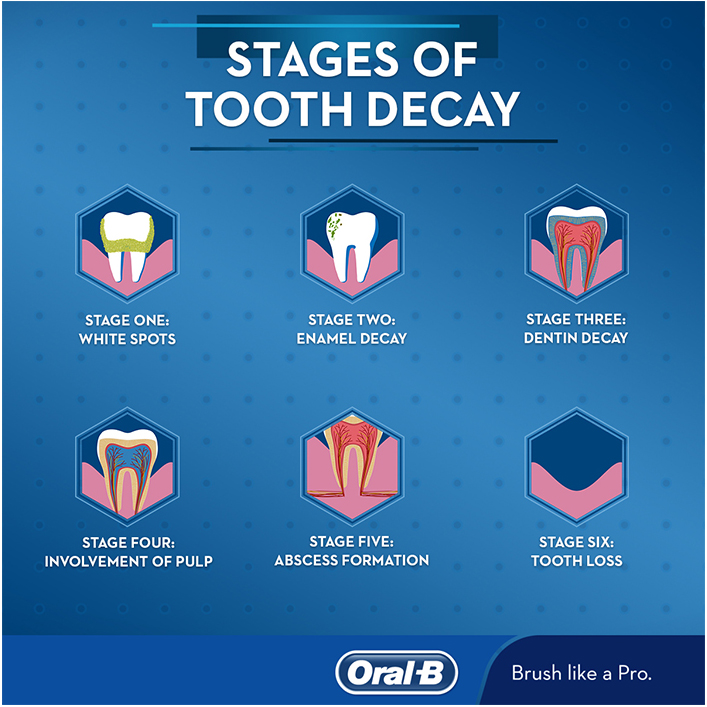Stages of Tooth Decay

Summary
Table of Contents

This blog has been reviewed and approved by Dr Robert Lee, a dental professional of 35 years
LEARN MORE >Tooth decay is the process of enamel softening caused by acids. It is also one of the most common causes of tooth pain and can also be prevented with the right oral care routine. Pain usually occurs when the enamel layer becomes thinner, which leaves the layer underneath more vulnerable to infection and the tooth prone to cavities. To better reduce your risk of cavities and tooth decay, it helps to understand the different layers of the tooth as well as how they are impacted across the stages of decay.
Tooth decay begins when the enamel begins to break down, creating pockets of decay on the surface of the teeth. Teeth are comprised of three layers:
- Enamel
Enamel is the outermost layer that helps protect your teeth from damage often caused by plaque bacteria, when not properly removed, that can lead to decay like cavities.
- Dentin
Dentin lies right underneath the enamel, when exposed, this second layer is prone to sensitivity.
- Pulp
The third layer is the Cementum which covers the roots of the tooth. The pulp is the tissue within the core of your tooth which houses the nerves and blood vessels making it the most sensitive layer of the tooth.
Tooth decay begins when the enamel begins to break down, creating pockets of decay on the surface of the teeth. Decay results from acidic damage to the tooth structure produced by bacteria that lives in plaque. Plaque is a soft sticky film formed by the bacteria found in one’s saliva metabolizing sugary foods left in the mouth. Some forms of tooth decay can be prevented by limiting sugary and sticky snacks, maintaining good oral care habits, and regular trips to your dental professional. The following image can help you identify and understand tooth decay, so you can help prevent it.

Causes of Tooth Decay
One of the main causes of tooth decay is the consumption of sweet and sticky foods and drinks. The more sugar you consume, the more acids are produced in the mouth leading to tooth decay.
Additional common causes of tooth decay and cavities include:
- Poor oral hygiene
A thorough oral care routine of brushing twice daily and flossing at least once a day removes the plaque bacteria that can lead to tooth decay. If plaque builds up on your teeth over a long period of time, it will begin to damage your enamel and eventually lead to tooth decay.
- Poor diet
If sticky, sweet or acidic foods are predominant in your diet, you are putting the health of your teeth at risk. Foods that stick to your teeth are difficult to remove and therefore more likely to stick around long enough to cause tooth decay. Sugar is also harmful - the more of it you eat, the more acids are produced leading to tooth decay. When you eat such foods, it is important to clean your teeth as soon as possible by drinking plenty of water, brushing and flossing.
- Location of the tooth
Molar or back teeth are more susceptible to cavities because they are harder to reach when brushing and flossing. Plus, these teeth have grooves on their surface, which makes it easier for food debris to collect there.
- Changes and pregnancy
Stomach acids from morning sickness can cause enamel erosion. That is why it is especially important for pregnant women to be mindful of their oral care routine.
- Genes
Tooth decay depends on genetics. The diet of the future mother is also important - the teeth start to form as early as the 4th week of pregnancy; therefore, it is important to limit the intake of sugars and at the same time to eat lots of protein products. In this manner, the mother-to-be will take care of the condition of the child's teeth.
Enamel cannot be replaced, so it is important to take care of it. Below we discuss, step by step, what the tooth decay stages look like. Keep an eye on your teeth and as soon as you notice worrying symptoms, visit your dental professional and apply the methods recommended at the end of this article to help prevent tooth decay.
Stage One: White Spots
The first stage of tooth decay begins when chalky white areas on the surface of the tooth appear due to the loss of calcium and build-up of plaque. These areas are caused by bacteria in the plaque metabolizing sugars from food consumed. The bacteria produce acid as a by-product of the metabolic process. The buildup of these acids causes tooth enamel to deteriorate, a process referred to as demineralization of the tooth surface. At this phase, tooth decay might still be reversible with the proper treatment—which should be discussed with your dental professional, such as using appropriate brushing technique, a fluoride toothpaste, and applying a topical fluoride treatment. One of the best ways to prevent plaque buildup is to brush at least twice a day using a toothpaste with stannous fluoride and an electric toothbrush like the Oral-B iO. Its dentist-inspired round brush head expertly cleans tooth-by-tooth with micro-vibrations to deliver a professional clean feeling every day.
Stage Two: Enamel Decay
In stage two of tooth decay, the enamel starts breaking underneath the tooth’s surface. At this stage, if the natural remineralization process is unable to restore the proper enamel and minerals, it may cause a lesion to form within the tooth as acids are released over an extended period of time. As the decay persists, the surface of the tooth risks breaking, which is irreversible and can cause a hole or cavity to form. To better prevent enamel decay, it’s important to remineralize or fortify the enamel with fluoridated toothpaste before a cavity is formed.
Stage Three: Dentinal Decay
Stage three of tooth decay is known as dentinal decay. This occurs when the decay extends through the enamel into the dentin. The dentin is the part of the tooth that exists in between the enamel and the pulp. Once the decay reaches the dentin, it will spread quickly as the dentin is softer and less mineralized than enamel. When enough of the sub-surface enamel is weakened by the loss of calcium and phosphate minerals, the enamel collapses, and a dental cavity is formed and may be visible to the eye. To avoid dentinal decay, a dental filling will most likely be required to restore the tooth, however, this must happen before the decay reaches the dentin layer.
Stage Four: Involvement of The Pulp
The pulp is considered the tooth’s center. It is made up of living tissue and it is where the nerve and blood supply are located. If the pulp of a tooth gets infected with bacteria, the exudate (pus) that forms can lead to an abscess which can be very painful. The gums and face may swell which can affect speech. At this stage, the most common courses of treatment are either root canal therapy which is then followed by the placement of a crown when caught early, or extraction if the tooth structure is completely lost.
Stage Five: Abscess Formation
Tooth abscess formation is by far the most painful stage of tooth decay. It means that the infection has passed through the pulp, reached the apex of the tooth root, and is now in the tissue and bone surrounding the tooth root. This stage also increases the risk that the neighbouring bones will also become infected. The area swells and becomes extremely painful. The gums and tongue then often become swollen, which can make speaking difficult and cause other complications. Additional surgery may be necessary at this stage.
Stage Six: Tooth Loss
Severe and untreated dental caries can affect the tooth root and surrounding gum tissue, causing the tooth to loosen over time. If you ignore the early stages of tooth decay and do not treat the tooth, it will have to be removed.
Tooth Decay Prevention
Tooth decay is preventable. The causes of tooth decay can vary, so only preventive measures can protect your teeth against cavities and other oral issue such as gum disease. Take good care of your diet, oral hygiene, and make regular visits to your dental professional. In addition to frequent brushing, it is also important to choose the right fluoride toothpaste, which thoroughly cleans the surface of your teeth and at the same time protects against demineralisation of the enamel.
Establishing an oral care regimen that involves these preventive measures will help avoid tooth decay:
- Use toothpaste and mouthwashes with fluoride. Fluoride is effective in treating initial enamel decay and fluoridation has been proven to reduce decay in children. The U.S. Task Force on Community Preventive Services, a blue-ribbon panel of experts, examined 21 studies and concluded (2000) that fluoridated water reduces tooth decay by a median rate of 29% among children of ages 4 to 17.
- Floss daily and brush with an electric toothbrush. Studies show that brushing with an electric toothbrush like the Oral-B iO can help reduce tooth loss by removing more of the plaque bacteria that leads to decay. A strong oral care regimen of brushing 2X/day for 2 minutes each session and flossing at least 1X/day can maintain your oral health and is regarded as the best preventative measure to take to avoid tooth decay.
- Avoid a diet high in sugar as well as eating between meals. Cavities most often affect children whose diet is rich in sweets and sugar. Sugar itself does not cause tooth decay - the decay develops when bacteria in the mouth break down sugars to produce acid, which demineralizes the hard tissues of the teeth (enamel and dentin). Excess sugar (and therefore bacteria) can lead not only to tooth decay but also to gum disease and can even cause tooth loss.
- Drink plenty of water. Staying hydrated can help produce saliva to continue to nourish teeth enamel and to clean the mouth. By drinking water, you rinse the sugars from your mouth, and the less sugars you drink, the less bacteria that feed on it. This means less risk of tooth decay.
- Visit your dental professional for regular checkups that will both help prevent tooth decay and maintain healthy oral care. Checkups of your oral health should take place at least once every six months.
If you suspect you have any form of tooth decay, reach out to your dental professional right away for proper diagnosis and treatment.
From Oral-B, the #1 dentist-recommended toothbrush brand, worldwide.
Sources
- http://www.oralhealthplatform.edu/our-work/the-state-of-oral-health-in-europe/ Yaacob M, ey al… Powered versus manual toothbrushing for oral health. Cochrane Database of Systematic Reviews 2014, Issue 6. Art. No.:CD00282. DOI:10.1002/14651858.CD002281.PUB3
- Kantar.https://onlinelibrary.wiley.com/doi/epdf/10.1111/jcpe.13126
- https://www.nidcr.nih.gov/health-info/tooth-decay/more-info/tooth-decay-process
Table of Contents
- Causes of Tooth Decay
- Stage One: White Spots
- Stage Two: Enamel Decay
- Stage Three: Dentinal Decay
- Stage Four: Involvement of The Pulp
- Stage Five: Abscess Formation
- Stage Six: Tooth Loss
- Tooth Decay Prevention
-
- Sources
- Related Articles

This blog has been reviewed and approved by Dr Robert Lee, a dental professional of 35 years
LEARN MORE >
Send Tips
for plaque removal tips, expert advise, and exclusive offers.

Send Tips
for plaque removal tips, expert advise, and exclusive offers.







